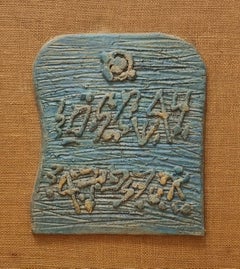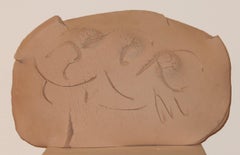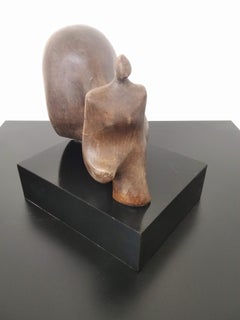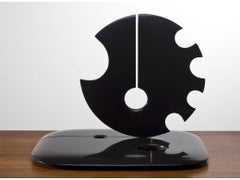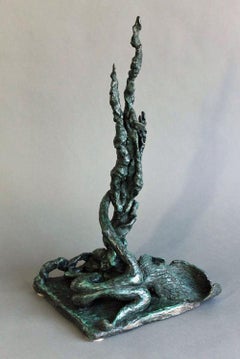1970s Abstract Sculptures
to
16
91
47
26
11
25
Overall Width
to
Overall Height
to
4
11
1,344
8,055
2
2
6
9
13
32
123
200
273
222
1
75
36
14
8
5
3
2
2
2
1
1
1
1
1
1
102
34
30
28
27
15
9
5
4
4
1
168
25
Period: 1970s
Antique Hebrew letters
By Moshe Castel
Located in Jerusalem, IL
The subject of Castel’s early paintings were scenes of Sephardic Jews in the Holy Land. In 1947, Castel helped to found the "New Horizons".In the 1950s Moshe's Castel artwork work was inspired by ancient relief paintings depicting predecessors of the Jewish people...
Category
Abstract 1970s Abstract Sculptures
Materials
Ceramic
"Symbiosis" a Kinetic Sculpture by Michael Secter
Located in Dallas, TX
Born in Winnipeg Canada, Michael Sectors work and craftmanship has been praised as remarkable. He brings contemporary techology to serve his art directing the fabrication of his work...
Category
1970s Abstract Sculptures
Materials
Steel
Abstraction
Located in Greenwich, CT
Abstract terracotta sculpture
Category
Abstract 1970s Abstract Sculptures
Materials
Terracotta
Untitled
Located in Barcelona, BARCELONA
Includes a Certificate of Authenticity
Category
Modern 1970s Abstract Sculptures
Materials
Wood
CARLA LAVATELLI “Black Sun” Belgian Marble Moving Sculpture 1971 FEMALE ARTIST
Located in Rancho Santa Fe, CA
An exquisite 1971, 2-piece movable black Belgian marble sculpture by Carla Lavatelli.
"Black Sun is part of a playground series. The grooves represent areas where water flows and th...
Category
Modern 1970s Abstract Sculptures
Materials
Marble
Woman Lying Down & Growing with Tree bronze sculpture by Yulla Lipchitz
Located in Hudson, NY
Organic, abstract bronze sculpture by Yulla Lipchitz of a woman lying down with a tree.
About this artist: Yulla Lipchitz, née Halberstadt, was born on April 21, 1911 in Berlin, Ge...
Category
Modern 1970s Abstract Sculptures
Materials
Bronze
Untitled Relief
Located in Palo Alto, CA
Victor Vasarely Untitled Relief, 1973 is a Studio Line Rosenthal Porcelain relief with aluminum that is hand-signed by Victor Vasarely (Hungary, 1906 – France, 1997) on verso. Number...
Category
Op Art 1970s Abstract Sculptures
Materials
Porcelain
Guggenheim (Black)
Located in London, GB
Perspex form, vacuum formed acrylic and spray painted black, 1970, signed and dated verso, from the edition of 106, although an edition of 750 was planned it was not fully executed, published by xartcollection, Zurich, 59 x 59 x 9.8 cm. (23.2 x 23.2 x 3.9 in.)
In 1970 British-Pop artist Richard Hamilton was invited to produce an edition of 750 small-scale multiples of the Guggenheim. The intention was to produce vacuum-form reliefs in Perspex and offset the costs of expensive molds by creating a large edition. In the end, the project proved more technically difficult than anticipated. Of the three colours (black, white and chrome), only a total of 271 were realised, 117 in white.
The xartcollection was created in 1968 in Zurich, Switzerland by Sandro Bocola...
Category
Pop Art 1970s Abstract Sculptures
Materials
Etching, Aquatint
Sculpture In The Form Of A Bicycle Saddle
Located in Miami, FL
TECHNICAL INFORMATION:
Claes Oldenburg
Sculpture In The Form Of A Bicycle Saddle
1976
Glazed brown ceramic with mahogany base and sand
14 x 8 1/2 x d: 8 1/2 in.
Edition of 36
Signed...
Category
Pop Art 1970s Abstract Sculptures
Materials
Ceramic
Abstraction
Located in Greenwich, CT
Abstract terracotta sculpture
Category
Abstract 1970s Abstract Sculptures
Materials
Terracotta
Geometrical Clouds. Silver Cloud
Located in Henderson, NV
Clifford Singer's Geometrical Clouds Series has evolved since 1974.
Category
Abstract Geometric 1970s Abstract Sculptures
Materials
Polystyrene, Acrylic
$14,400 Sale Price
20% Off
Geometrical Clouds. White Cloud
Located in Henderson, NV
Clifford Singer's Geometrical Clouds Series has evolved since 1974.
Category
Abstract Geometric 1970s Abstract Sculptures
Materials
Polystyrene, Acrylic
$14,400 Sale Price
20% Off
Untitled
Located in Austin, TX
Abstract Sculpture by American Artist Jack Youngerman, from the Atlantic Ritchfield art collection. Abstract Form rotating on marble base. Initialed JY (Jack Youngerman, American, b....
Category
Abstract 1970s Abstract Sculptures
Materials
Fiberglass
Price Upon Request
Song
Located in Palo Alto, CA
Victor Vasarely Song, 1970 is a painted wood relief that is hand-signed by Victor Vasarely (Hungary, 1906 – France, 1997) on verso. Numbered from the edition of 55 on verso.
Category
Op Art 1970s Abstract Sculptures
Materials
Wood, Paint
Price Upon Request
Bellatrix
Located in Palo Alto, CA
Victor Vasarely Bellatrix, 1970 is a painted wooden relief on aluminum that is hand-signed by Victor Vasarely (Hungary, 1906 – France, 1997) and is inscribed ' VASARELY E.A. VII' on ...
Category
Op Art 1970s Abstract Sculptures
Materials
Wood, Paint
Price Upon Request
Lead Singer, bronze, sculpture, Allan Houser, Native American, Drummer, Apache
By Allan Houser
Located in Santa Fe, NM
Lead Singer, bronze, sculpture, Allan Houser, Native American, Drummer, Apache
Allan Houser Haozous Warm Springs Chiricahua Apache 1914-1994 National Medal of Arts awardee Allan Houser (Haozous), Chiricahua Apache (1914-1994) Selected Collections Centre Georges Pompidou, Paris, France * “They’re Coming”, bronze Dahlem Museum, Berlin, Germany Japanese Royal Collection, Tokyo, Japan “The Eagle”, black marble commissioned by President William J. Clinton United States Mission to the United Nations, New York City, NY *"Offering of the Sacred Pipe”, monumental bronze by Allan Houser © 1979 Presented to the United States Mission to the United Nations as a symbol of World Peace honoring the native people of all tribes in these United States of America on February 27, 1985 by the families of Allan and Anna Marie Houser, George and Thelma Green and Glenn and Sandy Green in New York City. National Portrait Gallery, Smithsonian, Washington, DC * Portrait of Geronimo, bronze National Museum of American Art, Smithsonian, Washington, D.C. * “Buffalo Dance Relief”, Indiana limestone National Museum of the American Indian, Smithsonian, Washington, D.C. *Sacred Rain Arrow, (Originally dedicated at the US Senate Committee on Indian Affairs, US Senate Building) “Goat”, “To The Great Spirit” - dedicated in 1994 at the Vice President’s Residence in Washington, D.C.. Ceremony officiated by Hillary Rodham Clinton and Tipper Gore. Oklahoma State Capitol, Oklahoma City, Ok * “As Long As the Waters Flow”, bronze Gilcrease Museum, Tulsa, OK *Sacred Rain Arrow, bronze Fort Sill, Oklahoma *”Chiricahua Apache Family”, bronze Donated and dedicated to Allan Houser’s parents Sam and Blossom Haozous by Allan Houser and Glenn and Sandy Green The Heard Museum, Phoenix, Arizona *Earth Song, marble donated by Glenn and Sandy Green The Clinton Presidential Library, Arkansas * “May We Have Peace”, bronze The George H.W. Bush Presidential Library, College Station, Texas *"Offering to the Great Spirit", bronze The British Royal Collection, London, England *Princess Anne received "Proud Mother", bronze in Santa Fe Allan Houser’s father Sam Haozous, surrendered at the age of 14 with Geronimo and his band of Warm Springs Chiricahua Apache people in 1886 in Southern Arizona. This was the last active war party in the United States. This group of Apache people was imprisoned for 27 years starting in Fort Marion, Florida and finally living in captivity in Fort Sill, Oklahoma. Allan Houser was born in 1914. His artwork is an ongoing testimony to Native life in America – its beauty, strength and poignancy. Allan Houser is from the culture and portrayed his people in an insightful and authentic way. Because of the era in which he lived, he had a rare understanding of American Indian life. Allan was the first child born after the Chiricahua Apaches were released from 27 years of captivity. Allan grew up speaking the Chiricahua dialect. Allan heard his father’s stories of being on the warpath with Geronimo and almost nightly heard his parents singing traditional Apache music. Allan’s father knew all of Geronimo’s medicine songs. Allan had an early inclination to be artistic. He was exposed to many Apache ceremonial art forms: music, musical instruments, special dress, beadwork, body painting and dynamic dance that are integral aspects of his culture. His neighbors were members of many different tribes who lived in Oklahoma. Allan eagerly gained information about them and their cultures. Allan gathered this information and mentally stored images until he brought them back to life, years later, as a mature artist. Allan Houser was represented by Glenn Green Galleries (formerly known as The Gallery Wall, Inc.) from 1973 until his death in 1994. The gallery served as agents, advocates, and investors during this time. In 1973 the Greens responded enthusiastically to the abstraction and creativity in Houser’s work. They were impressed, not only with his versatility and talent but with the number of mediums he employed. His subject matter was portrayed in styles ranging from realism, stylized form to abstraction. With encouragement from the Greens, Houser at the age of 61, retired from his post as the head of the sculpture department at the Institute of American Indian Arts in Santa Fe, New Mexico in 1975 to begin working full-time creating his art. The next 20-year period was an exciting time for Allan, the gallery, and for the Green family. He created a large body of sculpture in stone, wood and bronze. For many years Glenn Green Galleries co-sponsored many editions of his bronzes and acted as quality control for the bronze sculptures according to Houser’s wishes. As both agents and gallery representatives, the Greens promoted and sold his art in their galleries in Phoenix and Scottsdale, Arizona and in Santa Fe, New Mexico. They had bi-annual exhibits in their galleries to feature Houser’s newest work and sponsored and arranged international museum shows in America, Europe and Asia. They travelled for these events including a trip to Carrara, Italy to the famed quarries of Michelangelo and together co-financed and arranged the purchase of 20 tons of marble. A watershed event for Allan Houser’s career occurred in the early 1980’s when Glenn Green Galleries arranged with the US Information Agency a touring exhibit of his sculpture through Europe. This series of exhibits drew record attendance for these museums and exposed Houser’s work to an enthusiastic art audience. This resulted in changing the perception of contemporary Native art in the United States where Houser and Glenn Green Galleries initially faced resistance from institutions who wanted to categorize him in a regional way. The credits from the European exhibits helped open doors and minds of the mainstream art community in the United States and beyond. Senator Daniel Inouye of Hawaii was a supporter of Allan Houser’s artwork. We worked with Senator Inouye on many occasions hosting events at our gallery and in Washington D.C in support of the formation of the Smithsonian’s National Museum of the American Indian in Washington, D.C. and other causes supporting Native Americans. Allan Houser is shown below presenting his sculpture “Swift Messenger” to Senator Inouye in Washington, D.C.. This sculpture was eventually given to the National Museum of the American Indian, Smithsonian’s permanent collection. It is now currently on loan and on display in the Oval Office. President Biden’s selection of artwork continues our gallery’s and Allan’s connection to the White House from our time working with Allan Houser from 1974 until his passing in 1994. “It was important for President Biden to walk into an Oval that looked like America and started to show the landscape of who he is going to be as president,” Ashley Williams...
Category
Contemporary 1970s Abstract Sculptures
Materials
Bronze
Untitled
Located in Laguna Beach, CA
DeWain Valentine was active in Los Angeles during the emergence of the Light and Space movement, alongside artists Larry Bell, Craig Kauffman, and Ken Price, all of whom he admired. ...
Category
Minimalist 1970s Abstract Sculptures
Materials
Resin
Price Upon Request
Star of Peace
By Yaacov Agam
Located in Missouri, MO
Yaacov Agam
"Star of Peace" c. 1970s
Metal
Ed. 2/300
approx. 9 x 2 x 2 inches
Born in Israel on May 11, 1928. His father was a rabbi, a Talmudic scholar and a Kabbalist. The famil...
Category
Abstract 1970s Abstract Sculptures
Materials
Metal
Price Upon Request
Square Wood Window Sculpture
By David Nash
Located in Houston, TX
Organic sculpture by famous sculptor David Nash of a tree trunk that has been shaped into a square with a concentric square cut out in the middle.
Artist Biography:
David Nash is a British sculptor and Land artist and works primarily with natural materials and live trees. His wooden sculptures are made using heavy equipment including chainsaws and blowtorches, morphing trees into unexpected shapes such as his Oculus Block (2010), a melding of two Eucalyptus stumps into a solid square. Born on November 14, 1945 in Esher, England, he attended the Kingston College of Art and later the Chelsea School of Art. Among his first and best-known works is Ash Dome (1977), for which the artist planted a circle of ash trees to form a wooden dome...
Category
Modern 1970s Abstract Sculptures
Materials
Wood
Price Upon Request
SKY CASE XII
Located in New York, NY
wooden sculpture of found objects painted black. case with lid and hinges.
Category
American Modern 1970s Abstract Sculptures
Materials
Wood
Price Upon Request
Recently Viewed
View AllMore Ways To Browse
Old World Landscape Painting
Olga Alexandrovna
Olivier Lavorel
On Kawara
Orazio Gentileschi
Original Vintage Bullfight Posters
Oskar Bergman
Otto Altenkirch
Otto Stark
Otto Van Veen
Oval Dog Painting
P English Paintings
Paddle Board Painting
Painting By J Philippe
Painting By Numbers Vintage
Painting By Whipple
Painting Indian Horseback
Painting Of St Francis
